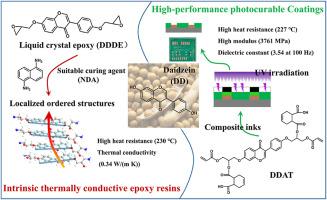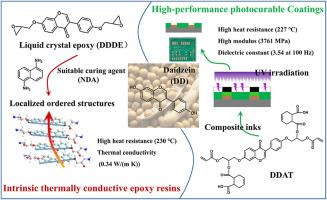Unlocking intrinsic thermal conductivity in BioBased liquid crystal epoxy and enabling alkali-developable photocurable dielectric coatings from epoxidized daidzein
IF 4.5
2区 化学
Q2 POLYMER SCIENCE
引用次数: 0
Abstract
The development of biobased renewable resources is expected to alleviate the threat to the ecological environment and the obstacles to sustainable development caused by relying on fossil fuels. Here, based on biobased daidzein (DD) with rigid benzene rings and two hydroxyl groups was firstly prepared into epoxy compound (DDDE) by reacting with epichlorohydrin. Daidzein is a liquid crystal mesogen, by curing with 1,5-naphthalene diamine (NDA) in the liquid crystal state, the locally ordered structure can be preserved, thereby exhibiting intrinsic thermal conductivity characteristics. The curing system DDDE/NDA105 (105 means cured at 105 °C) under liquid crystal phase obtained better thermal conductivity (λ = 0.34 W/(m·K)), storage modulus (G’ = 2548 MPa), and glass transition temperature (Tg = 230 °C) than E51/NDA. On the other hand, photocurable alkali developer resin (DDAT) was synthesized by DDDE with acrylic acid (AA) and tetrahydro phthalic anhydride (THPA), and subsequently, a series of DDAT/DDDE/filler composite inks were prepared. Finally, the C8:2 ink stands out on PCB with the comprehensive performance of tensile strength (53.67 ± 1.41 MPa), elongation of fracture (4.11 ± 0.23 %), G’ (3761 MPa), Tg (227 °C), and dielectric constant (3.54 at 100 Hz). The present work broadens the application of bio-based daidzein in high-performance inherently thermally conductive epoxy resins and alkaline developing photocuring inks.


揭示生物基液晶环氧树脂的固有导热性及用环氧大豆苷元制备碱显影光固化介质涂层
生物基可再生资源的开发有望缓解依赖化石燃料对生态环境的威胁和对可持续发展的阻碍。本文首先以具有刚性苯环和两个羟基的生物基大豆苷元(DD)为原料,与环氧氯丙烷反应制备环氧化合物(DDDE)。大豆苷元是一种液晶介介物,在液晶状态下与1,5-萘二胺(NDA)固化,可以保持其局部有序结构,从而表现出固有的导热特性。在液晶相下,DDDE/NDA105(105指105℃固化)的导热系数(λ = 0.34 W/(m·K))、存储模量(G′= 2548 MPa)和玻璃化转变温度(Tg = 230℃)均优于E51/NDA。另一方面,用DDDE与丙烯酸(AA)和四氢邻苯二酸酐(THPA)合成光固化碱显影剂树脂(DDAT),制备了一系列DDAT/DDDE/填料复合油墨。最后,C8:2油墨的抗拉强度(53.67±1.41 MPa)、断裂伸长率(4.11±0.23%)、G′(3761 MPa)、Tg(227℃)、介电常数(100 Hz时3.54)等综合性能在PCB上脱颖而出。本研究拓宽了生物基大豆苷元在高性能固有导热环氧树脂和碱性显影光固化油墨中的应用。
本文章由计算机程序翻译,如有差异,请以英文原文为准。
求助全文
约1分钟内获得全文
求助全文
来源期刊

Polymer
化学-高分子科学
CiteScore
7.90
自引率
8.70%
发文量
959
审稿时长
32 days
期刊介绍:
Polymer is an interdisciplinary journal dedicated to publishing innovative and significant advances in Polymer Physics, Chemistry and Technology. We welcome submissions on polymer hybrids, nanocomposites, characterisation and self-assembly. Polymer also publishes work on the technological application of polymers in energy and optoelectronics.
The main scope is covered but not limited to the following core areas:
Polymer Materials
Nanocomposites and hybrid nanomaterials
Polymer blends, films, fibres, networks and porous materials
Physical Characterization
Characterisation, modelling and simulation* of molecular and materials properties in bulk, solution, and thin films
Polymer Engineering
Advanced multiscale processing methods
Polymer Synthesis, Modification and Self-assembly
Including designer polymer architectures, mechanisms and kinetics, and supramolecular polymerization
Technological Applications
Polymers for energy generation and storage
Polymer membranes for separation technology
Polymers for opto- and microelectronics.
 求助内容:
求助内容: 应助结果提醒方式:
应助结果提醒方式:


